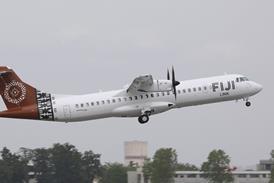Industry observers "-will be amazed at how quickly things will turn around in Asia."
So says Larry S Dickenson, Boeing Commercial Airplane Group's senior vice-president, Asia/Pacific, whose comments show the company's confidence that the region's economic crisis will be short-lived and do little harm to Boeing's medium to long-term prospects here.
As it is, Boeing claims it will account for 77% of all airliner deliveries in Asia this year.
"According to our initial projections we thought the crisis might cost us orders for as many as 60 aircraft. But so far, we haven't seen anything of this magnitude," says Dickenson.
However, he declines to give figures on exactly how many orders are in serious jeopardy, saying only that the company "-is talking with our regional customers to see how we can help tailor their needs to meet the economic difficulties."
But Dickenson does dismiss suggestions that Philippines Airlines (PAL) may cancel orders placed for 747s.
"I can tell you categorically that they have not cancelled the order." Nevertheless, Dickenson does not rule out that the delivery of some of the aircraft may be postponed. PAL spokesmen have already publicly stated that the airline wants to defer four of the eight 747s on order.
Dickenson observes that while the economies of Thailand and South Korea are showing signs of turning around soon, other countries in the region have political situations they must first overcome.
Vital
He says Japan must play a greater role in fixing the regional economy. "It is such a huge market that its recovery is vital for the other countries in Asia."
In the longer term, Boeing is convinced that Asia-Pacific will remain a key market. It estimates that the region will require 4,845 new jetliners over the next 20 years to meet growing traffic and to replace ageing aircraft.
"Nearly 70% of the firm orders for jetliners now awaiting delivery in the region were placed with Boeing, accounting for about one-third of total backlog orders.
"At the same time, the 747 and the 777 are receiving about half their global orders from Asia-Pacific carriers. By comparison, about 32% of Airbus's A330 sales and 28% of the larger A340 are coming from Asia."
Dickenson dismisses Airbus's recent success in the region, pointing out that "-on long flights, the cross-section and personal space on an aircraft are very important, and in these respects the 777X is superior to anything the Europeans have.
"Our data shows that the engine is not a quantitative issue with airliners."
Boeing is not only looking to corner the long-haul carrier segment, but also the short- to medium-range routes with its new 717.
Delivery
"The new aircraft is vital as intra-regional travel increases," points out Dickenson. AirTran Airlines is the launch customer, and will take delivery of the first aircraft in the summer of 1999.
The 717 was originally launched as the MD-95, but renamed after the McDonnell Douglas-Boeing merger.
For the project to be successful, "-a complete family of aircraft will be necessary, and not just the current mid-sized 717-200," says Dickenson. Although the models have not yet been decided, it is thought likely they'll include a small-sized 717-100 and a larger 717-300.
"Given the current financial restraints, it is not surprising that most Asian carriers express interest in the possible acquisition of the 717, but not in the short term."
Source: Flight Daily News























